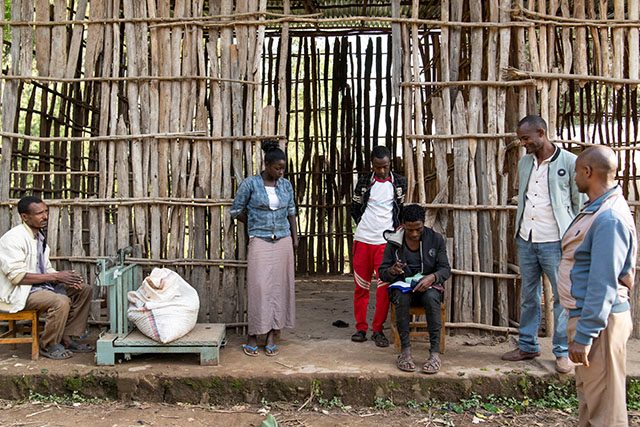
ADDIS ABABA — Endale Terefe remembers a time when he used to go to school so hungry he had trouble staying awake during lessons.
The 14-year-old student in Ethiopia’s capital, Addis Ababa, was living with his aunt after his parents died.
“My aunt has no money to buy food,” he said. “So I was obliged to come to school with no lunch box and felt sleepy in class.”
Then, three years ago, he and other students in the city started getting two free school meals a day through local charities.
“I am now attending the class attentively,” Terefe said with a smile.
As drought in parts of Ethiopia makes food less available and more expensive nationwide, millions of students, including in cities, are going to school hungry — if they go at all.
But while the federal government provides rural schools with free food in times of drought, the task of feeding students in the capital has typically been left to charities.
That changed in January when the Addis Ababa government launched its own “school feeding program” for tens of thousands of children, aiming to combat rising urban hunger as climate change is predicted to intensify dry spells.
Lower crop yields on farms across Ethiopia have resulted in declining food supplies to cities, said Esubalew Abate, assistant professor of food and nutrition security at Addis Ababa University.
The consequences include soaring food prices and double-digit inflation, which put a massive financial strain on city dwellers already struggling with a lack of housing and high poverty rates, he told the Thomson Reuters Foundation.
The impact of drought in rural areas of Ethiopia has been evident in Addis Ababa over the last four years, Abate said.
“Whenever there is drought, it is very clear that the food price increases (in the city),” he added.
El niño effect
Belaynesh Ferede, 45, a mother of two who lives in Addis Ababa, said the prices of many staples had jumped dramatically in just the last four years.
For example, the price of a kilogram of teff — Ethiopia’s staple grain — rose from 20 birr to 30 birr ($0.70 to $1), while a kilo of potatoes doubled from 10 birr to 20 birr.
“Living has become expensive in the city,” she said.
And for many children in Addis Ababa, where 80% of people live in slums, according to the charity Habitat for Humanity, those high food prices mean going to school on an empty stomach.
The indirect effect of climate extremes on education became clear in 2015-2016, when El Niño — a warming of sea-surface temperatures in the Pacific — hit an already drought-stressed Ethiopia, tipping it into the worst drought in 50 years.
Relief agencies reported that students were falling asleep or feeling sick in class, attendance rates fell and dropout rates spiked, as children were either too hungry to go to school or had to stay home to help their families look for food.

To keep children in class in the wake of El Niño, the Ethiopian government launched a $50-million emergency program in drought-hit rural areas, which gave about 6 million students free school meals over three years.
The U.N. World Food Programme observed that the program stabilized school attendance rates, with fewer dropping out.
“Even students who had dropped out a long time ago returned to school,” it said in a report.
The Addis Ababa government hoped to see the same positive results among the city’s school children with this year’s feeding initiative.
It has allocated 169 million birr for free meals in all the city’s primary schools, covering more than 50,000 children.
“Education for all is a global motto and access to education is a matter of right, so the city government has a responsibility to feed students,” said Meti Tamrat, the program’s coordinator at the Addis Ababa Education Bureau.
The city program complements school-meal projects run by local charities that continue to provide meals for about 80,000 students.
But not all needy students have yet been covered, Tamrat noted, adding it was still too early to measure the impact of the city government’s initiative.
Research by the Ye Enat Weg Charitable Association, which has provided free school meals since 2014, showed that by 2018, the dropout rate in Addis Ababa’s schools had fallen by 75% and students’ academic scores had improved by 14% since 2006.
‘Huge lesson’
As Addis Ababa works to stop rural droughts hurting education in the city, the federal government is looking to launch another feeding program that will support children all over the country.
According to the ministry of education’s emergency school meal plan for 2019, more than 1 million children in drought-affected areas are still coming to school hungry.
Meanwhile, the Famine Early Warning Systems Network has warned that the majority of households in five regions of Ethiopia face a crisis-level food shortage through September 2019 due to a combination of drought and conflict.
Instead of offering free school meals only in emergency situations, the federal government wants to implement an ongoing program in all primary schools, said Bereket Takele, advisor for the program at the Ministry of Education.
Mitigating the impact of drought on the education sector has now become a priority for Ethiopia, he added.
“The government has learned a huge lesson about how drought can affect students,” Takele said. “There is a saying: ‘Challenge is an opportunity’.”
— Reporting by Dagim Terefe; Editing by Jumana Farouky, Sebastien Malo and Megan Rowling (Thomson Reuters Foundation)









